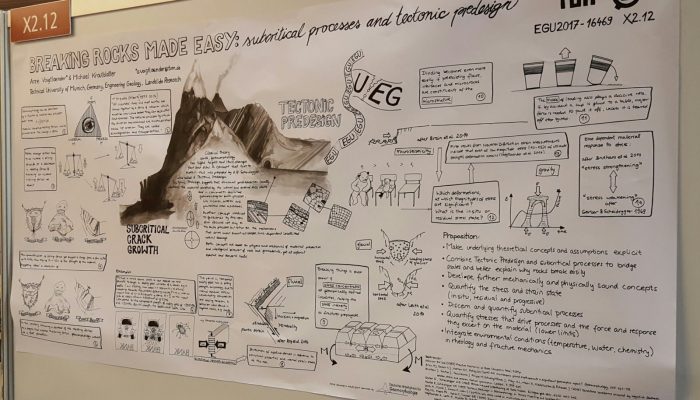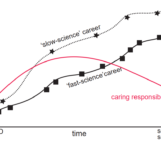
Anne Voigtländer (TUM Munich) presented her poster at the EGU 2017 and attracted quite some attention. She drew everything per hand and besides chocolate bars and smiling mountains she touched some very interesting topics. Have a look and get inspired!
– written by Anne Voigtländer (TUM Munich) –
Have you ever tried to sell a text on theoretical geomorphology to students? Or even to your fellow scientists? Why is it a seemingly hard and boring topic? Well, reading a paper on theoretical geomorphology is seldom thrilling and you nearly never go about telling everybody about it – unless it has a sexy name like “badass geomorphology”. Even though it might be hard to digest, we base and structure our research, implicitly or explicitly, on those concepts, assumptions and rules/model perception. So why is it so unsexy to talk about theoretical geomorphology? One reason could be that abstract terms are used to describe even more abstract assumptions, i.e. “landscape sensitivity”, “barrier to change”, which suggest how we can discern and interpret processes, forms and interrelations. Hence they leave us with many vague terms and still no really good impression on what it is about, and more important, why the underlying theoretical assumptions matter. And isn’t the overall goal of presenting posters and writing articles, on whatever the topic might be, to be thought provoking?
Could theoretical geomorphology be, theoretically speaking, made sexy?
With my EGU 2017 poster (EGU2017-16469) I tried to tread off the traditional path overcoming some of the aforementioned issues, by focusing on apprehensive and playful graphics to explain theoretical thoughts on geomorphology. In geomorphology we already employ a figurative, formative and illustrative language and topics, so I decided to try out a comic strip-style to introduce and combine two theoretical concepts, namely subcritical crack growth and tectonic predesign. Both concepts touch on fundamental assumptions of driving (processes) and resisting (material) forces promoting fractures, landforms and landscapes without great force. I tried to use real world examples, like breaking a bar of chocolate, where you exploit the grooves to focus stresses. This then allows very little force to initiate and propagate a fracture through the chocolate or bedrock. By placing such images in your mind the theoretical part might be even sweet.
Communication of research and science, and with it the theoretical concepts we base it on, is essential. The abstract terms and academic mystification can act as barriers, which might hinder exchange and integration of our theoretical assumptions. But I am positive that we can change it.
– written by Anne Voigtländer (TUM Munich) –



Thomas Klekamp, PG
One can’t be a geologist without also being an artist! Such a relief from the mundane poster. Congratulations.